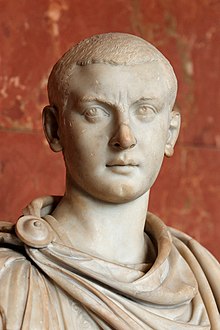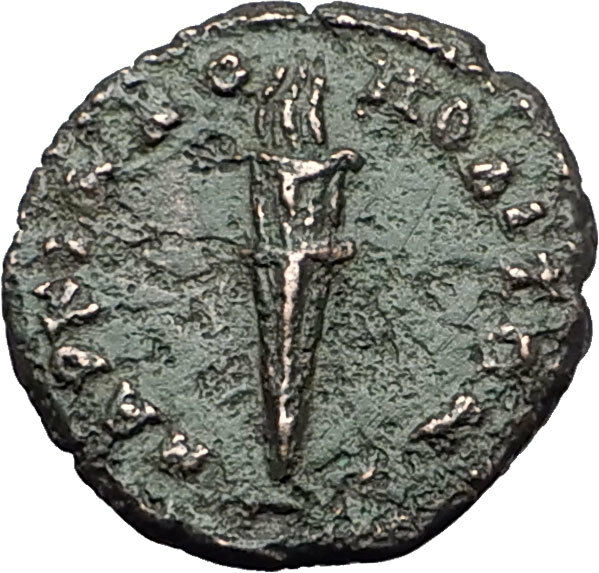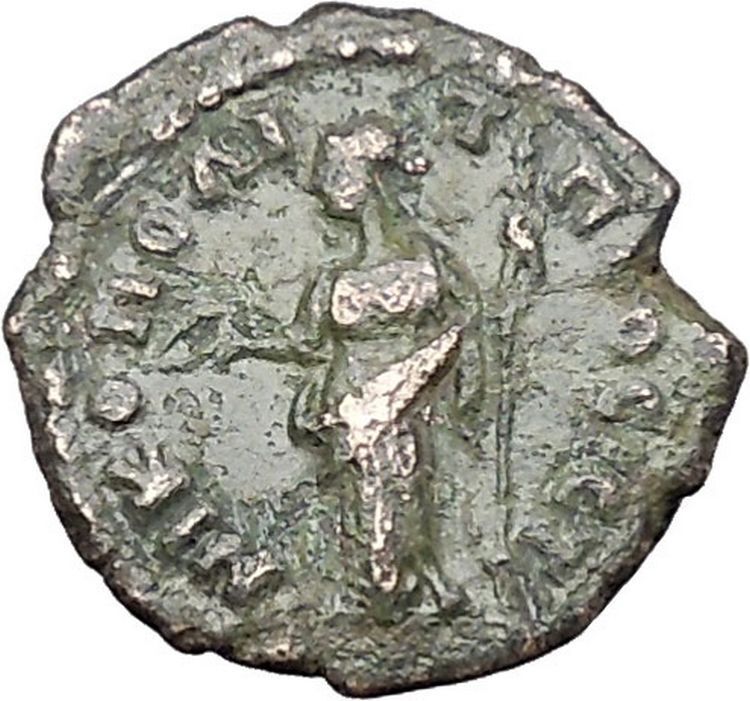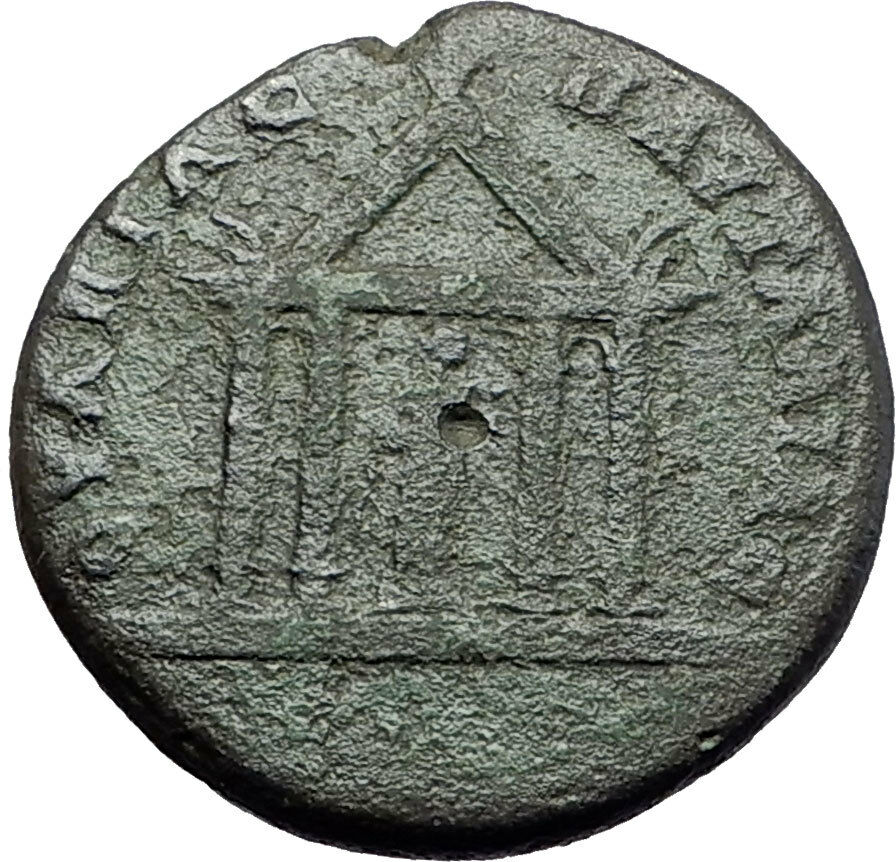|
Gordian III – Roman Emperor: 238-244 A.D.
Bronze 22mm (6.64 grams) Deultum in Trace Thrace mint, 238-244 A.D.
Reference: Varbanov 2891
GORDIANVS IMP AVG, laureate cuirassed bust left, holding shield and spear
C F P D, forepart of bull head right.
You are bidding on the exact item pictured, provided with a Certificate of Authenticity and Lifetime Guarantee of Authenticity.
_07.jpg/330px-Mosaico_Trabajos_Hércules_(M.A.N._Madrid)_07.jpg) In Greek mythology, the Cretan Bull was the bull Pasiphaë fell in love with, giving birth to the Minotaur. In Greek mythology, the Cretan Bull was the bull Pasiphaë fell in love with, giving birth to the Minotaur.
The Seventh Labour of Heracles
Whistling merrily at his success so far, Heracles was then sent to capture the bull by Eurystheus as his seventh task. He sailed to Crete, whereupon the King, Minos, gave Heracles permission to take the bull away as it had been wreaking havoc on Crete by uprooting crops and leveling orchard walls. Heracles sneaked up behind the bull and then used his hands to strangle it, and then shipped it to Eurystheus in Tiryns. Eurystheus, who hid in his pithos at first sight of the creature, wanted to sacrifice the bull to Hera, who hated Heracles. She refused the sacrifice because it reflected glory on Heracles. The bull was released and wandered into Marathon, becoming known as the Marathonian Bull. Theseus would later sacrifice the bull to Athena and/or Apollo. Eurystheus then sent Heracles to bring back the man-eating Mares of Diomedes.
Capture by Theseus
Androgeus, a son of Minos and Pasiphaë, competed in the games held by Aegeus, King of Athens. He won all the games, so angering Aegeus that he had the young man killed (some legends claim that he was sent to confront the Bull itself). Devastated, Minos went to war with Athens and won. As punishment, the Athenians had to send several youths every 9 years to be devoured by the Minotaur.
Aegeus’ own son, Theseus, set to try to capture the Bull. On the way to Marathon, Theseus sought shelter from a storm in the shack owned by an old lady named Hecale. She swore to make a sacrifice to Zeus if Theseus was successful in capturing the bull. Theseus did capture the bull, but when he returned to Hecale’s hut, she was dead. Theseus built a deme in her honor. He then dragged the Bull to Athens where he sacrificed it.
Theseus then went to Crete where he killed the Minotaur with the help of Minos’ daughter Ariadne.
Origin
When the moon has reached the constellation of Taurus, it has passed over an area that the ancients referred to as the sea – the region from Capricorn to the region containing Aries. It was referred to as the sea due to the high concentration of constellations identified as sea creatures within it, Aries being identified as a golden flying ram who flew over the sea. Crete is in a direct line from the natural harbor of Argo, a direction which due the shape of Argo’s harbor, and surrounding coastline, requires that all ships initially take this course.
Apart from being a bull, Taurus contains a very bright and red star (Aldebaran), meaning that many took it to be evil. Some forms of Greek mythology associated the constellation with the tame white bull, in some versions Zeus in disguise, that seduced Europa and took her to Crete (Minos), whereas others associate it with the white bull that fathered the Minotaur. The Cretan Bull which fathered the Minotaur was originally calm and sent from Poseidon, but king Minos whom it was sent to fell out of favor with Poseidon, and so in some versions of the story, Poseidon made the bull angry.
The myth of Poseidon sending the bull (which seduced Minos’ wife) may simply be an earlier version of the myth of Zeus seducing Europa, as in earlier Mycenean times, Poseidon had significantly more importance than Zeus. The change of gods was due to the replacement of the Mycenean culture and religion, with a later one favoring Zeus. Poseidon and Zeus, may be the result of the parallel evolution of the same original god in separate cultures, one (Poseidon – who is also associated with horses) becoming associated more with the sea (due to change in the main source of trade), and thus eventually becoming noticeably different.
Gordian III – Roman Emperor: 238-244 A.D.
Caesar: 238 A.D. (under Balbinus and Pupienus)
Augustus: 238-244 A.D.
| Grandson of Gordian I | Nephew of Gordian II | Adopted Successor of Balbinus and Pupienus | Husband of Tranquillina |

Gordian III (Latin: Marcus Antonius Gordianus Pius Augustus; 20 January 225 AD – 11 February 244 AD) was Roman Emperor from 238 AD to 244 AD. At the age of 13, he became the youngest sole legal Roman emperor throughout the existence of the united Roman Empire. Gordian was the son of Antonia Gordiana and an unnamed Roman Senator who died before 238. Antonia Gordiana was the daughter of Emperor Gordian I and younger sister of Emperor Gordian II. Very little is known of his early life before his acclamation. Gordian had assumed the name of his maternal grandfather in 238 AD.
In 235, following the murder of Emperor Alexander Severus in Moguntiacum (modern Mainz), the capital of the Roman province Germania Superior, Maximinus Thrax was acclaimed Emperor. In the following years, there was a growing opposition against Maximinus in the Roman senate and amongst the majority of the population of Rome. In 238 a rebellion broke out in the Africa Province, where Gordian’s grandfather and uncle, Gordian I and II, were proclaimed joint emperors. This revolt was suppressed within a month by Cappellianus, governor of Numidia and a loyal supporter of Maximinus Thrax. The elder Gordians died, but public opinion cherished their memory as peace-loving and literate men, victims of Maximinus’ oppression.
Meanwhile, Maximinus was on the verge of marching on Rome and the Senate elected Pupienus and Balbinus as joint emperors. These senators were not popular men and the population of Rome was still shocked by the elder Gordian’s fate, so the Senate decided to take the teenager Gordian, rename him Marcus Antonius Gordianus like his grandfather, and raise him to the rank of Caesar and imperial heir. Pupienus and Balbinus defeated Maximinus, mainly due to the defection of several legions, particularly the II Parthica, who assassinated Maximinus. However, their joint reign was doomed from the start with popular riots, military discontent and an enormous fire that consumed Rome in June 238. On July 29, Pupienus and Balbinus were killed by the Praetorian Guard and Gordian proclaimed sole emperor.
Rule
Due to Gordian’s age, the imperial government was surrendered to the aristocratic families, who controlled the affairs of Rome through the Senate. In 240, Sabinianus revolted in the African province, but the situation was quickly brought under control. In 241, Gordian was married to Furia Sabinia Tranquillina, daughter of the newly appointed praetorian prefect, Timesitheus. As chief of the Praetorian Guard and father in law of the Emperor, Timesitheus quickly became the de facto ruler of the Roman Empire.
In the 3rd century, the Roman frontiers weakened against the Germanic tribes across the Rhine and Danube, and the Sassanid Empire across the Euphrates increased its own attacks. When the Persians under Shapur I invaded Mesopotamia, the young emperor opened the doors of the Temple of Janus for the last time in Roman history, and sent a large army to the East. The Sassanids were driven back over the Euphrates and defeated in the Battle of Resaena (243). The campaign was a success and Gordian, who had joined the army, was planning an invasion of the enemy’s territory, when his father-in-law died in unclear circumstances. Without Timesitheus, the campaign, and the Emperor’s security, were at risk.
Gaius Julius Priscus and, later on, his own brother Marcus Julius Philippus, also known as Philip the Arab, stepped in at this moment as the new Praetorian Prefects and the campaign proceeded. Around February 244, the Persians fought back fiercely to halt the Roman advance to Ctesiphon. Persian sources claim that a battle occurred (Battle of Misiche) near modern Fallujah (Iraq) and resulted in a major Roman defeat and the death of Gordian III. Roman sources do not mention this battle and suggest that Gordian died far away from Misiche, at Zaitha (Qalat es Salihiyah) in northern Mesopotamia. Modern scholarship does not unanimously accept this course of the events. One view holds that Gordian died at Zaitha, murdered by his frustrated army, while the role of Philip is unknown. Other scholars, such as Kettenhofen, Hartman and Winter have concluded that Gordian died in battle against the Sassanids.
Philip transferred the body of the deceased emperor to Rome and arranged for his deification. Gordian’s youth and good nature, along with the deaths of his grandfather and uncle and his own tragic fate at the hands of the enemy, earned him the lasting esteem of the Romans. The soldiers held Gordian in high esteem, as he had possibly sacrificed his life to save them in 244.
|





_07.jpg/330px-Mosaico_Trabajos_Hércules_(M.A.N._Madrid)_07.jpg) In Greek mythology, the Cretan Bull was the bull Pasiphaë fell in love with, giving birth to the Minotaur.
In Greek mythology, the Cretan Bull was the bull Pasiphaë fell in love with, giving birth to the Minotaur.





